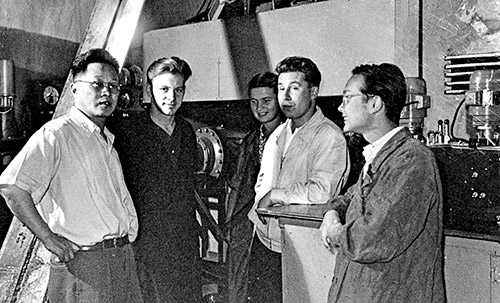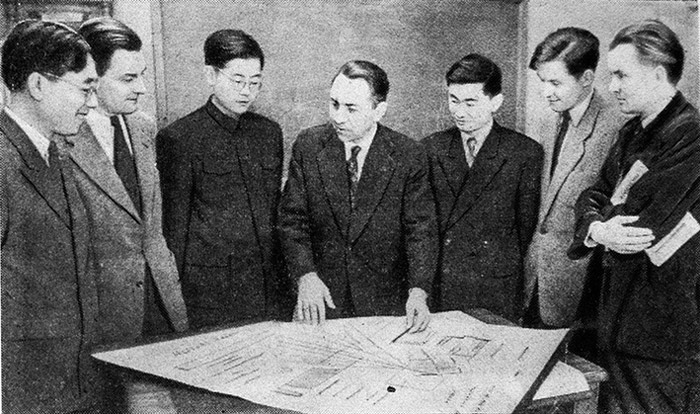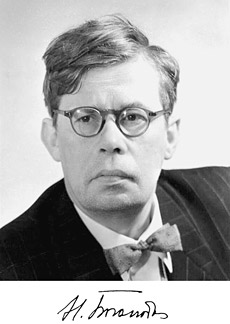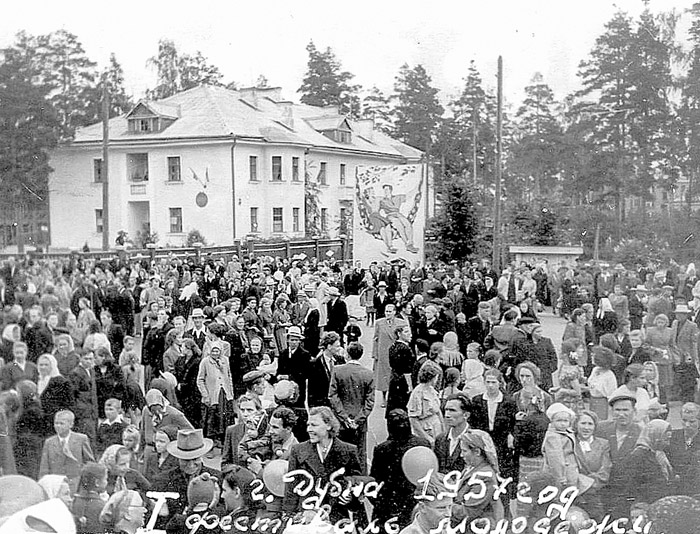
Electronic english version since 2022 |
The newspaper was founded in November 1957
| |
|
Number 40 (4788) |
Historical overview
JINR issues results
Institute Dubna - 1957
Dmitry Ivanovich called the first years of JINR the spring of our Institute. It was a turbulent and eventful spring. Following the sign change, the first, still cosmetic changes began. The international scientific centre was taking a shape. By the end of 1957, 104 foreign specialists had already been injected into Dubna, some with their families. The Chinese physicist Wang Ganchang became Head of the Bubble Chamber Sector at LHEP. The Polish experimental physicist Marian Danysz and the Czech theoretical physicist Vaclav Votruba became JINR Vice-Directors. All Member States were represented on the Institute's Scientific Council, all except, initially, North Vietnam that didn't yet have its own nuclear physics department1. That's why, in a letter to JINR Director D.I.Blokhintsev, a 27-year-old hydraulic engineer Nguyen Dinh Tu frankly admits he's a newcomer to the field. But "the Party said it had to be done" and in two and a half years, this young man not only mastered a new profession but also co-authored a scientific discovery.

Vice-Director M.Danysh, Director of DLNP V.P.Dzhelepov, Vice-Director V.Votruba, Administrative Director of JINR V.N.Sergienko, Director of JINR D.I.Blokhintsev, Director of LHEP V.I.Veksler, Assistant Director of JINR A.M.Ryzhov, Director of BLTP N.N.Bogolyubov, Director of FLNR G.N.Flerov
The world's leading theorists received invitations to work for two or three months, to lend the Institute a European polish and raise its level. Yang, Lee, Feynman, Gell-Mann, Yukawa - what names! And also, Peierls, Schwinger... Only Weisskopf responded: unfortunately, he couldn't. The "brotherhood of physicists" that developed in the 1920s and lasted until the second half of the 1930s, as Dmitry Ivanovich had dreamed, was unfortunately not revived.

Member of the Scientific Council, Vice-Director of JINR in 1959-1960, Head of the Bubble Chamber Sector at LHEP, Professor Wang Ganchan and the employees of his Sector that have not yet been encumbered with degrees and titles L.N.Strunov, E.N.Kladnitskaya, M.I.Soloviev and Ding Dacao
One after another, JINR employees opened a window to Europe: not only the top but also the second-ranking officials went on assignments abroad. In the pages of the newly founded city newspaper "For communism", Spartak Korenchenko, a researcher at the Laboratory of Nuclear Problems, shared his impressions of the Meson Physics Conference held in Venice (and of course, of Venice itself). JINR Directorate managed to send Professor Hu Ning there, despite the lack of diplomatic relations between China and Italy; later, this obstacle was overcome with Professor Heinz Pose's assignment to London. And Sergey Polikanov, the future Deputy Director of the Laboratory of Nuclear Reactions and Flerov's favorite student, flew to Copenhagen at the end of the year to deliver a report.

Professor Hu Ning (China), Frank Kashlun (GDR), Zhao Zhongzhao (China), Director of the Laboratory of Nuclear Problems V.P.Dzhelepov (USSR), Duan Yishi (China), Ryszard Sosnowski (Poland), Dumitru Neagu (Republic of Poland). Venedikt Petrovich is introducing the representatives of the Member States to the scheme for extracting accelerated particle beams from the synchrocyclotron chamber. From the issue №2 of the newly founded newspaper "For communism" from 16 November, 1957.
The Institute expands with new laboratories. Following the Laboratory of Theoretical Physics, the Laboratory of Neutron Physics that was announced at the first session of the Scientific Council, has its director. The date of I.M.Frank's appointment became the Laboratory's birthday. It's too early to talk about the Laboratory's scientific achievements. There's no building, no experimental facilities and the Laboratory's staff, including the director, can be counted on the fingers of one hand (by the end of the year, two). Meanwhile, people from Obninsk worked on the development of the experimental facilities, the world's first pulsed nuclear reactor.
By decision of the Scientific Council, the MZI department was separated from the Laboratory of Nuclear Problems and its Head G.N.Flerov became director of the Laboratory of Nuclear Reactions. He continued to work part-time in Moscow. The MZI facility - the future U-300, the experimental base of the Laboratory of Nuclear Reactions was still in the drawing boards and calculations. Georgy Nikolaevich and his staff from Sector No.7 worked on the 1.5-meter cyclotron at the Kurchatov Institute, preparing to synthesize transuranic elements.
As for actual scientific achievements, this is still the work of the first two laboratories, donated to the international scientific centre in their finished form at its inception (a line from Pushkin's "The Captain's Daughter" comes to mind: "While my mother was still pregnant, I, by the grace of our close relative, Major Prince V. of the Guards, was already enlisted in the Semenovsky Regiment as a sergeant"). A highlight of the year was the launch of the Veksler synchrotron. In March, the Tsar accelerator showed its first signs of life and in April, LHEP physicists and engineers reached a record-breaking 10 GeV. It marked a triumph for Soviet science and technology, as the atomic giant, with a record-breaking magnet mass of 36,000 tons, was developed without a single "Western nail".
 At the 3rd session of the Scientific Council, Academician N.N.Bogolyubov reported on a new technique in the theory of superconductivity. The title of the report should not be misleading. In fact, it was both a new technique and a new theory. Bogolyubov relied on his own 1946 investigation on superfluidity and the mathematical apparatus developed to describe this phenomenon. The "initiating impulse", as D.V.Shirkov put it, was a note by the American theorist Leon Cooper that first discovered the key to unraveling the nature of superconductivity (D.V.Shirkov wrote about all of this succinctly and exhaustively2). The members of the Scientific Council listened to the report with great attention. Dmitry Ivanovich asked a question, Leopold Infeld admitted that he hadn't understood everything the first time and wasn't ready to ask and the others respectfully were silent. The credit for developing the theory of superconductivity was later given to three Americans that published their paper earlier, one of whom, incidentally, was Cooper himself. Although the theory is named after the first letters of their last names, BCS, the theorists prefer to use Bogolyubov's mathematical apparatus in their investigations.
At the 3rd session of the Scientific Council, Academician N.N.Bogolyubov reported on a new technique in the theory of superconductivity. The title of the report should not be misleading. In fact, it was both a new technique and a new theory. Bogolyubov relied on his own 1946 investigation on superfluidity and the mathematical apparatus developed to describe this phenomenon. The "initiating impulse", as D.V.Shirkov put it, was a note by the American theorist Leon Cooper that first discovered the key to unraveling the nature of superconductivity (D.V.Shirkov wrote about all of this succinctly and exhaustively2). The members of the Scientific Council listened to the report with great attention. Dmitry Ivanovich asked a question, Leopold Infeld admitted that he hadn't understood everything the first time and wasn't ready to ask and the others respectfully were silent. The credit for developing the theory of superconductivity was later given to three Americans that published their paper earlier, one of whom, incidentally, was Cooper himself. Although the theory is named after the first letters of their last names, BCS, the theorists prefer to use Bogolyubov's mathematical apparatus in their investigations.
The discovery carried out that year in the Department of Nucleon Interactions at the Laboratory of Nuclear Problems is worth examining in more detail. This instructive story of two scientific results, one of which became a prologue to the other (as V.P.Zrelov, a participant in those events, put it), has its roots in the days of the GTL-IYAPAN. Georgy Leksin, M.G.Meshcheryakov's first graduate student that joined the laboratory shortly after the synchrocyclotron's reconstruction, went beyond the scope of his thesis and stumbled upon an unexpected effect: when an accelerated proton collided head-on with a heavy hydrogen nucleus, the nucleus did not disintegrate but absorbed the impact as a whole, even though the proton's energy was hundreds of times greater than the binding energy in the nucleus3. It contradicted the notion of the deuteron as a loose structure. Mikhail Grigorievich summoned the young theorist Boris Barbashov to his office and suggested he take a break from his fascinating investigations of quantum field theory and provide a theoretical basis for the unexpected effect. As Boris Mikhailovich himself later wrote, he was unable to provide a theoretical basis but - here's the quote: "...conversations with M.G.Meshcheryakov and G.A.Leksin enriched my understanding of the physical picture of this process." The publication was delayed.
 |
| Professor Heinz Pose, a member of the JINR Scientific Council and a participant in the Soviet Atomic Project, had worked at the future Laboratory of Nuclear Problems since 1955. From the memoirs of one of his sons, Rudolf Pose: "Although G.Pose was already working at the open Institute of Nuclear Problems of the USSR Academy of Sciences at that time, his presence in Ivankovo was still classified. Therefore, not only was he unable to participate in expert meetings, but his presence in Ivankovo was even concealed from the German participants." |
None of this could have been foreseen in 1957. Therefore, Mikhail Grigorievich modestly (Igor Vasilievich taught us modesty, he told his young colleagues) reported on the scientific result his group had obtained. D.I.Blokhintsev gave a co-report; he found an explanation for both effects and introduced the term "flucton" into scientific circulation. Georgy Leksin figuratively called it a "prompt elementary particle" and A.V.Efremov subsequently interpreted the flucton in terms of quantum chromodynamics as a multiquark formation. So, Venedikt Petrovich that at a crucial moment for MG said, "Meshcheryakov doesn't need to be removed; he has three successful projects and there won't be any conflicts," was right about at least one thing.
Georgy Leksin defended his thesis and left for ITEP that he can only regret. Many years later, during a meeting with his supervisor, Leksin admitted that he had also written a poetry version of his thesis:
- Our task is to measure
The pd-elastic cross section.
The giant synchrocyclotron
Gives us a fast proton,
Then we throw it
Into a container of pure D2O,
There a collision occurs
And to the astonishment of all minds,
Not backward, not sideways, almost forward
Heavy hydrogen flies.
What is the conclusion of these wise men?
The three-particle effect has been discovered.
May it be glorified throughout the ages,
My boss, M.G.Meshcheryakov!
"Why didn't you read it at your defense!" Mikhail Grigorievich was disappointed…
A hypothesis put forward that year by Bruno Pontecorvo also had far-reaching consequences. It involved neutrino oscillations. Its occurrence was experimentally proven, as was the occurrence of antineutrinos and the fact that they are not identical. Bruno Maksimovich's attention was drawn to an article by A.Pais and O.Piccioni, in which the authors considered the possibility of neutral K-mesons converting from a particle to an antiparticle and back and he suggested that the same could happen with neutrinos. After the occurrence of different types of neutrinos became an experimental fact, Bruno Maksimovich revised his hypothesis and continued to refine it as more and more was learned about this particle. Only Parkinson's that had been debilitating his health for the past 15 years, prevented him from seeing the rest of this story and learning that neutrino oscillations had been detected experimentally.
P.S. Summing up the past year, Dmitry Ivanovich wrote in his diary: "The Council and the session of the Committee of Plenipotentiaries have concluded. I'm delighted by the friendly, warm atmosphere, the 'sense of support', everyone views it as their own cause, vital and loyal. This is perhaps the greatest result of this session. A moral and political victory over skeptics like Professor L.Infeld5 that has completely changed and instead of his former sarcastic remarks speaks of the Institute radiating ideas and thoughts. Much work still lies ahead but the main thing is to unite closer, in a close-knit formation…"

Science isn't the only thing that brings nations together. The 6th International Festival of Youth and Students, held that summer in Moscow, also brought them closer together. Festival participants gave a concert in Dubna. A report on this event became the first film produced by the amateur studio "Dubna-Film". Along with the Festival, rock 'n' roll burst onto Dubna's cultural scene.
Notes
1 Albania didn't have nuclear physics either but physics itself existed and at meetings of the Scientific Council, the country was represented by Petrak Pilika, Head of a department at the University of Tirana. His last appearance at the Scientific Council was in 1961 and that's where the Albanian trace in the history of the institute's Dubna ends. The country's participation in JINR was purely symbolic (a laconic entry in Dmitry Ivanovich's work journal: "Albania -273°C").
2 D.V.Shirkov wrote: "The trigger for Nikolay Nikolaevich was the publication of Cooper's brief note that proposed that the basis of the phenomenon was the correlation of electron pairs, due to interaction with the ion core... N.N. immediately saw an analogy with the phenomenon of pairwise boson correlations in his theory of superfluidity. Taking as a basis the Frohlich Hamiltonian of the interaction of electrons with excitations of the electron lattice and modifying his (u,v)-transformation from the theory of superfluidity to the case of fermions, Bogolyubov employed a new, virtuoso technique..."
3 As A.V.Efremov emphasized, it was, in fact, the first observation of the cumulative effect in nuclear physics, discovered by V.S.Stavinsky in the early 1970s.
4 This episode from the history of pre-Iyaev Dubna inspired three chapters in the novella "Goddess of Victory" by writer Nikolay Asanov. The writer met Mikhail Grigorievich while vacationing in Koktebel. The story's hero, a young, talented physicist Alexey Goryachev arrives in Dubna near Moscow in the hopes of confirming his discovery:
"So, you've actually isolated them? How often do they appear?"
"One event every ten minutes."
"Not much! And you want to find out if something similar happened in our experiments?..."
...In the laboratory, this heavyset man with the sad eyes of a poet..."
5 At the first session of the JINR Scientific Council in September 1956, Leopold Infeld played the role of "devil's advocate": after each speech, he took the floor and dropped another "Polish dig" - first saying he really liked everything and then tearing to pieces everything he'd liked so much (according to the memoirs of Chestimir Szymane, half a century later).
Alexander RASTORGUEV